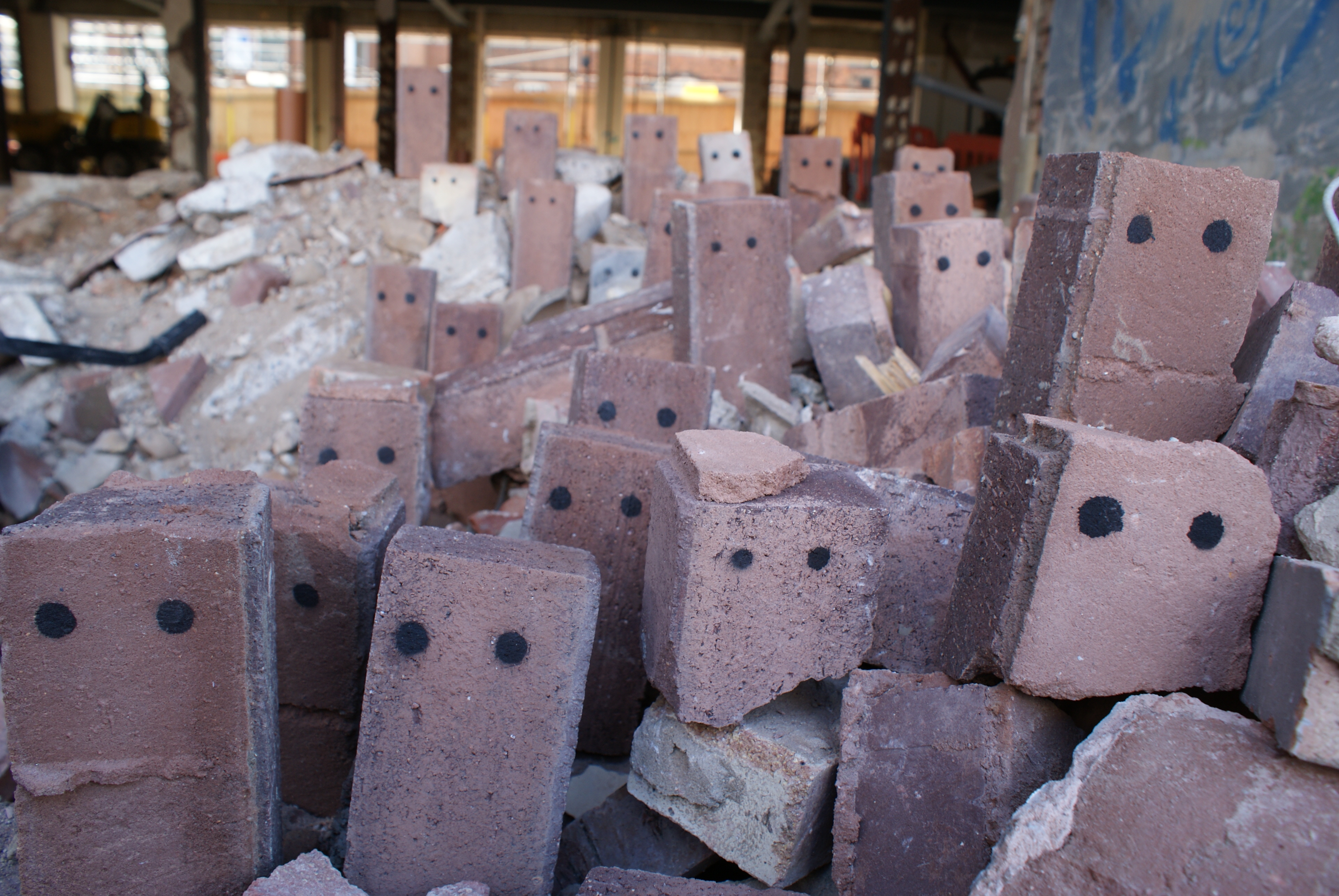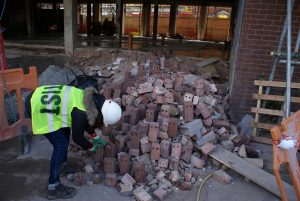
Introduction
I first came across ‘Jane’s Walks’1 in 2013 when I was designing ‘The Walton Trails,’ a series of walking trails in Walton-on-the-Naze on the north Essex peninsular. As I became acquainted with Jane Jacobs’ work I was more and more inspired; this housewife, come urban activist, who galvanised communities into standing up for what mattered to them, not what was aesthetically pleasing to councils and planners.
In this vein I set out to create a walk around my own neighbourhood which, in around 2010, had been earmarked for re-generation, and given the title ‘the Cultural Quarter.’ But did this title mean anything more than an expensive branding operation for the council, or was it a true reflection of the use of the location? To quote Jane Jacobs:
‘To approach a city, or even a city neighbourhood, as if it were a larger architectural problem, capable of being given order by converting it into a disciplined work of art, is to make the mistake of attempting to substitute art for life.’
Jane Jacobs
What had started this trajectory into cultural centre? Was there a precedent from the past for the area being a centre of culture, or one of following trends?
What were local people’s thoughts and feelings about the Cultural Quarter?
Could one use the walk as art to investigate the historical, and contemporary use of the area, and find out if the ‘cultural quarter’ concept was one the local people had embraced or rejected?
This was something new to Jane’s Walks, and to Colchester.
These are some of the questions I set out to investigate though my walk. I proposed the following to the group of people who came on the walk;
- I’m passionate about where I live, the place the people, the community and will be talking about some of them on the route, about how the ‘Cultural Quarter’ concept has affected the area, and I will be asking you how you feel it has.
- I’m going to investigate this through installation, participation and conversation.
- I invite you to use your senses as we walk the route to interpret the spaces in a new way, to see, hear smell and absorb the environment and look at it in new ways or re-evaluate how you see it.
- There are no right or wrong answers on this walk and I encourage you all to join in and discuss concepts and points raised at the points of interest and as we all walk.
In summary, I wanted to create an interactive short walk encouraging dialogue about the effect on the community of the areas transition into a cultural quarter, investigations and observations of the everyday through stories and archaeology of the familiar.
The Process Mapped
I submitted a broad proposal to Jane’s Walk Colchester, and then went about researching how artists had historically embraced the walk as part of their work, and current artists using the walk as part of their practice.
Walking the route a number of times, to collect artefacts and thought about how I could communicate with people along the route of the walk. I came up with the idea of creating a series of stopping points at which I would talk about two things; an installation placed there by me, or a history of the area, juxtaposed with a piece of information or fact about a walking artist inspired by the location.
As I physically mapped the area I thought about creating a numerical synergy, and ten seemed to be a good place to start, ten concepts or stories, ten artists. I hand drew as map and the installation concepts started to evolve from that…
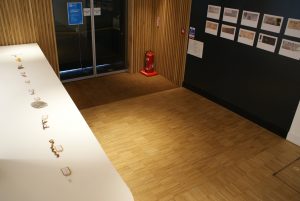
Artefacts
Inspired by Burton, Korda and Quaiman of walkwalkwalk1, I set out to collect artefacts from the cultural quarter, this ‘contemporary archaelology’ or ‘archaeology of the familiar’ forms a record of people passing through, what they were doing, what they had lost.
From these everyday objects I curated a collection of found objects or ‘objet trouvé.’ Some notable things that didn’t make the cut were; a bag of very small mixed fruit found in the Priory, a piece of toilet paper with ‘toxic waste’ printed on it, also in the Priory, biodegradable objects in the main including multiple chicken bones and a squashed mouse by the back gate at 37 Queen Street.
I recorded objects in the area, and took a panoramic photo of the location I found them at, I labelled and logged; time, place, location and object. These objects were displayed at 37 Queen Street at the start of the walk.
It’s a Fair Cop Guv
Heading out on my recce to look for places to visit en route, I started at my new studio space 37 Queen Street. The old police parking lot is still out the back of the building, and our manager Jack had sent out a link old photos of police cars parked in the space… it got me thinking!
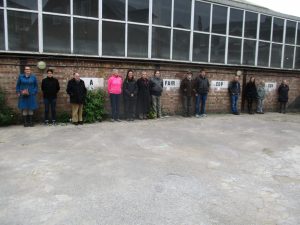
I stood in the area and noticed the white painted rectangle where the police and parking inspectors used to park, the names on these were long worn away so impossible to read, but as I stood there the concept for ‘It’s a Fair Cop Guv’ just came to me in an instant. I counted the rectangles and it was the perfect number.
The installation was made with hand-cut lettering and spray paint.
Prison Doors
My office in 37 Queen Street is in one of the former police cells. It’s now light and airy with large windows cut at one end and a glass front and door. However, the original metal prison doors I found out are still stored in the old sheds in the car park.
I had an idea about doing some audio, and had some recordings from within the prison I was had visited in the Czech Republic the previous year as a group of artists in residence. I had done a sound workshop at the University with Simon Keep (Fishclaw) and was inspired to use some low-tech methods to edit and re-play the sound. With a borrowed Dictaphone I played the audio back in my cell and re-recorded it live.
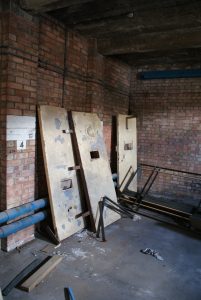
The resulting effect was degraded sound with a haunting effect when placed behind the metal doors; footsteps on loose tiles, metal gates shutting, and dystopian voices inaudible to the listener… I was even luckier when the day of the walk although supposedly spring was a dark and cloudy day (spring had not yet arrived this early in May) and as we filed into the large shed it was almost dark… the sound echoed around the dark room filled with bodies, not sure exactly what they were experiencing.
The Axel Sculpture – A Ready Made from History
Taking in the readymade Axel Sculpture that has recently been moved to the new Magistrates Court near Colchester Town (St Botolph’s) Station, I did some research and was fascinated by the rich history associated with it:
The earliest mention of the site dates back to 1811 by a William Dearn who was a nail maker.
It was sold 1860 to Joseph Blomfield, who sold Wheeler & Wilson sewing machines. In 1880s facing competition from the Singer Sewing Machine Company, it turned to manufacturing machine tools and oil engines. Also in the 1880s the Company started production of larger industrial lathes. In 1903 it was bought by the Nicholson brothers, who introduced the Britannia motor car, sales were poor as they were neither well made nor reliable.
Britannia Works closed around 1912, but reopened in WWI to manufacture munitions and war supplies. It reverted to the production of metal turning lathes for which it became world famous. During the late 1930s Britannia’s business again declined, closing in 1938, after which the Works stood derelict.
With the outbreak of WWII the British Government needed large numbers of powerful, yet compact, prime movers, the Paxman 12 cylinder VEE RB was already well developed and of proven performance. Eighty five percent of the staff taken on to build the engines were unskilled and mostly women.
After the war production of components for engines continued and Paxman produced an extensive range of precision hydraulic control equipment into the 60’s. After a long and eventful history the Works closed in 1982. The building was demolished in 1987 and the site is now the Britannia car park.
A short distance away, close to Colchester Town railway station and opposite the entrance to the new Magistrates’ Courts, a crankshaft from a 1946 Paxman RPH engine now stands on a plinth as a reminder of the old Britannia Works and Paxman’s activities there.
Richard Carr’s History of Paxman4
I used this history as a starting point to engage discussion about the importance of the area industrially and ask the question is ‘culture’ the new industry of this area that has seen so many trends in industry come and go?
The concept of artefacts as art bought up marcel Duchamp and the ‘readymade’ early in the walk, this was later raised again in the Axel sculpture which for my mind was infinitely more interesting when its history was uncovered a feeling the audience seemed to share.
Station Arches
Beneath the station are a series of arches which were probably used during the war in the loading and unloading of goods, they are all locked up with mesh gates over them today, but what was here that caught my eye was a piece of Tape Art – a naturally formed work of art, created from the repeated use of a poster board in the car park.
It always struck me that these spaces would be ideal as a covered market, small shops or cafés, something like the arches along Brighton seafront, if a little smaller. My question to the viewers was; why do places sit empty, can the empty spaces be adapted rather than building new?
Along the beginning of the station arches is a long raised pavement, as I thought about walking artists Marina Abramovic piece ‘The Lovers’ was bought to mind. In 1988 Abramovic undertook to walk the Great Wall of China with her long term collaborator Ulay, starting at either end the pair would meet in the middle. The project was fraught with complications in part because of military installations in the wall, and required seven years preparation and three months to complete; they met after walking for 90 days, sadly though this was where their relationship ended.
Part of the St Botolphs quarter plans were to build an estate of eco-houses in the car park next to this area, where the factory had once stood, and to my mind one of the down sides to this was that they didn’t plan for any parking for the housing, as in the future they felt Colchester will be a ‘car-less town’ so often planners have no grounding in the facts of daily life.
We are rushing through this area to get to the Priory before the park warden locks the gates at 7.00, I send one of the group on ahead to hold the gates…
‘Is what we get what we really want?’
I lived in this area for ten years, and almost every day I walk past the pear tree in the Priory Park, as such I have a huge admiration for it as it struggles through bad years and is abundant in good years, I wanted to include it, and there are a number of historical facts I gathered about pears trees, and in particular pears I that location that I decided to include;
‘It is probable that pears were cultivated in Britain during the Roman occupation but the production of the fruit was slow to develop although there is mention in the Domesday Book of old pear trees as boundary markers. By the 13th century many varieties of pears had been imported from France and the fruit was used mainly for cooking rather than eating raw.’
RV Roger Nurserymen 5
The building right behind St Botolph’s church became a Ministry of Defence bond store for Paxman spares purchased by the MOD. In the railway bay were some packers who made boxes for spares, for the bond store. The Development department shared offices with internal printing, tracers and the Works photographer. It is said the offices were stifling in the summer and freezing in the winter but that the wildlife was amazing. Tree creepers used to work the pear trees, foxes were common, one day a small deer appeared and even a pheasant.’
Edited from Richard Carr’s History of Paxman6
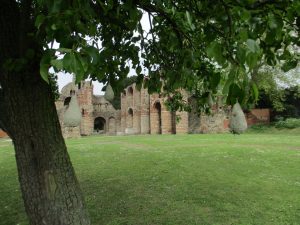 These interesting facts about pears set the scene for my intervention. Created in response to the 2010 regeneration of St Botolph’s Priory by Colchester Council, the plans were open to the public for feedback and were supplied to local residents to view and comment on, at the time I supplied a list of feedback including; please don’t cut down the pear tree it may be very old and of historical significance, don’t pave over the whole area near the church, we have precious little green space in town centres as it is (part of the grounds were sold off to redevelop the area.) Sometimes in their enthusiasm to ‘refresh’ a public area, (particularly in Colchester,) little thought is given to the elements there now and the public use of the area and attention is solely paid to a) Is there Roman remains below it or b) How will it look?
These interesting facts about pears set the scene for my intervention. Created in response to the 2010 regeneration of St Botolph’s Priory by Colchester Council, the plans were open to the public for feedback and were supplied to local residents to view and comment on, at the time I supplied a list of feedback including; please don’t cut down the pear tree it may be very old and of historical significance, don’t pave over the whole area near the church, we have precious little green space in town centres as it is (part of the grounds were sold off to redevelop the area.) Sometimes in their enthusiasm to ‘refresh’ a public area, (particularly in Colchester,) little thought is given to the elements there now and the public use of the area and attention is solely paid to a) Is there Roman remains below it or b) How will it look?
Thankfully they listened to local feedback and the pear tree and grass area remain, this piece is a reflection on the importance of standing up for the things in your environment you feel are important and not being bullied by town planner’s.
I had an assistant arranged to hang the pears and introduce them for me, but sadly on the day she couldn’t make it, so we nipped down to the Priory at the last minute, I was having a video filmed and they jumped in the car and shot a few shots, as I hung them in the tree, asking some teenagers and a couple of my neighbours in the park if they could watch over them. In the event they were still all there the next day, when I went to collect them, as the park had been locked after we passed thought it.
Walking Techniques
I wanted to have a part of the walk where the audience could get involved, I knew this may not be easy so I put it in the middle to allow them to have time to settle into the idea of communication as a group and get to know each other (not expecting so many participants!)
The experiment I tried was one of ‘mindful walking’ to ask the walkers to really consider the environment they were moving in, to think about the movement of those around them and to move in a different way to how they normally would.
Although I knew this would be challenging, but many of them did indeed join in, observing the sound where they walked, notice the surrounding all around them as they walked, walking close to the ground, walking heel to toe, following the gait of the person in front… and so on.
This piece was inspired by the work of Stefania Migliorati7, whose interactive walks can be done anywhere, simply by following a set of instructions for example; pick a place on a map to begin, take the first right, take 50 steps in the direction you prefer, take the first street you don’t know…
‘Along the line’
As one of the most well known artists in the realm of walking art, Richard Long8 was a person I really wanted to include. I felt that the Castle and Hollytrees Museums had been excluded from the ‘Cultural Quarter’ map and concept, as they didn’t offer building opportunities, so I decided to create and interactive piece inspired by Long here.
When I had walked the route the Hollytrees lawn had been smothered in daisies, and I envisaged marking up a rectangle and then asking the group to pick the daisies from that space only. I knew this was a long shot as they may well trim the grass between then and the walk, and sure enough when I returned to check it the day before it had been cut. So it was that early in the morning of the walk we were in the Priory picking daisies to make a Richard Long inspired installation.
I placed the bagged daisies in the fridge at the Studio (the start of the walk) and when I collected them before we set off they had all closed in the dark! So that aside we arrived at the lawn and I asked all the participants to take a small hand-full and create a ‘Long inspired installation.’ Off they set to work, not as I had imagined creating a hard edged geometric shape, but creating a meandering curving line that wiggled its way as far as it could on the supplies provided. I was quite elated by the way I had given them a material and a concept and they had taken it and run with it.
Memory, Place. (Ants…)
I have always been fascinated by the Factory Gates to no where, left abandoned in the car park in St Julian Grove, these are a relic of forgotten histories, the Paxman site was always unstable and went through constant fluctuations in popularity and decline. The street is believed to have originally been built to house the factory workers.
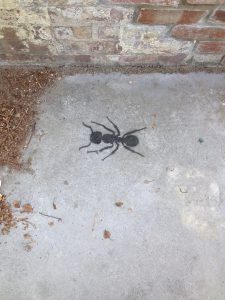 The ant installation was a directly inspired by the idea of a bustling industry of workers that must have come and go over these stairways in the past, and a moment of reflection to stop and consider the transition of industry to art.
The ant installation was a directly inspired by the idea of a bustling industry of workers that must have come and go over these stairways in the past, and a moment of reflection to stop and consider the transition of industry to art.
The ant stencil is cut by lazer into a polypropylene sheet, I had ordered a can of ‘contractor spray’ which breaks down after a few weeks. I doesn’t arrive in time, so I use regular spray paint but don’t prepare the area so it lays straight onto the dusty floor in the hope this will prevent it lasting permanently! I reduce the coverage of ants accordingly.
Field ii
One of the first ideas to form in my mind, and one of the last I was to pluck up the courage to ask about, was a tribute to the work of Antony Gormley9. Gormley had visited Colchester in 1999 to create a location installation ‘Field for the British Isles’ in the empty former Keddies Department Store, Roman House on Queen Street.

Field was a collaborative piece, created by communities and made from red clay, it filled the ground floor with thousands of small handmade figures, and the visitor book was filled with imaginative comments such as: “It’s like playing at Glastonbury!”
These had always stuck in my mind, and as I walked past the space I saw a pile of rubble and broken bricks in the gaping open rear of the building. They were stripping it out to make way for the new Curzon cinema. I visualised a stream of brick ‘people’ pouring over that mound, their terracotta colour and various forms not so different from the handmade sculptures that had invaded the space so many years before, and the building had then sat empty, until now…
I visualised the spirit of those hundreds, and knew I had to do it. But what would they say? It was only a few days before the walk I finally plucked up courage to go to the builders and ask, they invited me in to their Portocabin to see the site foreman, I waited with baited breath as he climbed all the ladders down from the top of the scaffolding. When he arrived I showed him my plan…
His response? ‘Yes.’ Simply yes, no debate or discussion, no health and safety lecture, just yes. I was absolutely thrilled and somewhat daunted at what I now had to do.
When we arrived on the day of the walk as arrannged, and they were having a delivery of five lorry loads of concrete to create a new floor where the Gormley installation had been. The foreman wasn’t there that day, but had informed his second in command we were coming, I had made myself an ‘ARTIST’ high-viz, and he supplied hard-hats to me and my assistant Harry.
He told us we had an hour or two to prepare at lunch time, and then we could come back after 3.30pm when the workers in that area left the site, and quickly install them. It was going to be a battle against time.
They created a fenced in safe area for us, but above us was a drop tube, and I was aware of what was around us at all times… I bought in a folding table and we started a production line, Harry would collect bricks, I would spray eyes on them, then put them to one side, it was noisy, heavy and dirty work, not aided by the fact that the cement lorries were tipping as we worked, so we would get the occasional cloud of cement or spray or water-vapour (as they washed it down afterwards) suddenly engulf us as we worked.
We toiled hard and fast, and left a row of about fifty bricks, we left the table set up so we could do more if needed. Upon our return we scrambled up the mound of scree and stuck them in, faces turned to us, we could see the lake of fresh concrete just behind where we were setting them, and they rose up over the hill towards us, as we slipped and clambered to fit them, we sprayed more pieces and ended up with roughly 75 bricks climbing over the mound. Using Gormleys rumoured technique to apply them thinly where perspective fills the gaps and to leave the back of the hummock clear.
In a matter of hours the piece was created. Still situated behind a wire fence with a thin cloth covering with holes in it. We left to prepare for the walk…
Additional Info: The Gormley installation was there from the Friday afternoon until the Monday morning, during that time it was also taken in by ‘7.00am with Ant’ walk, and people had the chance to go and see it, resulting in it becoming a trend on social media for those few days. On the Monday it was removed by the builders with all the rubble.
Supporting Literature
I created a hand drawn map from my original schematic, working up layers of watercolour and ink pen to map the route, its rough and readiness made it simple and approachable.
I wanted to give the audience something as I had been researching the idea of the ‘gift’ and so I created a booklet of photos of the root, with some quotations printed on tracing paper and folded over them, these were made by hand and I wasn’t sure how many to make, in the end the thirty I did make were all gone as we set off to walk…
High Viz
Inspired by Clare Iles and Mandy Roberts (Drawing St Botophs, 2014) I decide that I need something to differentiate me from the crowd, and I have some high-viz in the car, left over from our residency in Arras last year, so I use the lettering to spray ‘ARTIST’on the back of it. This doubles up as a useful uniform for the building site part of the adventure, and with thirty people on the actual walk it turns out to be propitious as its really hard work herding them all and not losing any of them!
Conclusions
In the event thirty people turned up for the walk, way more than I had expected.
People were keen to get involved, volunteering to have their photo taken at the very start with ‘It’s a Fair Cop Guv’ and they continued in this vein throughout the walk, interacting with stories and opinions, getting up close and exploring the places I took them to en-route. Engaging with the commentary I was making and adding their input to it. Particularly surprising me with their creative input for ‘Along the Line.’
Walkers Feedback Quotes:
Five words to describe the walk…
‘Fascinating, intriguing, inspiring, imaginative, fun.’
‘Fun, thoughtful, informative, many layered and slowed (compressed) time for a moment.’
I was surprised to discover…
‘The steps to the ‘once’ factory in back of the car park and how workplaces can so easily be obliterated.’
The ideas I will take back with me…
‘I found the walk really interesting and stimulating – a bit like a ‘kick up the ass. I really need to start getting more actively engaged with the local environment and people.’
‘Take more time to absorb a place.’
I was disappointed that…
‘It wasn’t longer.’
‘What once was purpose and gave life to a place can be so sanitized when the next set of developers come on the scene “all that is solid melts away10”.’
With reference to social impact, one of the walkers asked if us working on the building site was disrespectful to the people working there, my response was two fold; firstly we worked really hard for those few hours (to which my back could testify afterwards!) in the dirt and noise, alongside them. The builders came over to see us, they felt free to interact with us and talk to us, to take photos of what we were doing to put on social media, and for that one Friday they worked with an artist and her assistant making an installation, it broke the routine, it was fun, they laughed.
Furthermore I was the only woman on the site that day, I felt proud to have had the courage to create a work in this male-dominated domain, and if working with them that day inspired them, made them laugh and broke the monotony and I got to create the sculpture I had visualised every time I walked past for weeks, then I would argue it was a mutually beneficial relationship.
Perhaps the artist in residence has the same purpose in any workplace situation? To inspire, to challenge the way people see the work they do, the place they work in, and that part of this ritual is the respect of the artist for the workers and the intrigue of the workers as to the purpose and intention of the artist.
The legacy of ‘Space, Story, Artefact’ for me continues, both in everyday working relationships built with some of the people taking part who are at Space studios, ongoing feedback from people who were on the walk, and people reminiscing about the installations.
But also taking part in the walk was a couple of representatives from ‘Street Hunt’ Project for Colchester Arts Centre, who have invited me to do the walk again in the near future. Some of the areas I installed have changed a lot in the interim, and so I will have to give some thought to some new installations, and maybe to addressing some of the topics raised by the group on the first walk.
My own bias was often against the ideas of the planners, but the walkers surprised me with their knowledge of the area and expressing their support for some of the planning ideas I dismissed.
It was this readiness to express an opinion on their locale, validating the philosophy of Jane Jacobs, and most surprisingly people’s willingness to take part, if you give them a structured safe place to do so, that struck me most about the process.
The implications of the walk are; that given a forum of security, in which they are not judged, people are happy to commit to opinions about the social and physical development of their local area, and furthermore it is an effective communication tool for them to do so, one could argue that for town planners and councils it would be valuable to organise walking discussions as a research method at the start of the planning process.
Combined with art, it brings to the process a level platform to allow people to engage in the critical process, it is expected that everyone can have and can express an opinion on public art and they freely do so in Colchester with special note to the Firstsite Gallery, at which point I specifically asked that they do not enter into the usual debate of ‘did our tax payers money pay for this?’ and enter into a more critical debate about what they would like in the Cultural Quarter.
The answers to my research questions were given by interaction and as part of with this relational walk as art. In summary the ‘walk as art’ gave people a safe and open forum to express their opinions about the development of their local area, the feedback expressed a lasting memory of taking a different view on places that are familiar to them, of learning, of engaging, of inspiring creative work and of the impact the work had on some of them.
Moving forward I will be looking for new, interesting and inspiring ways to interact with community and place though art.
Further Information
Place Story Artefact:
Exploring the Walk as Art with Sara Hayes
16th September 2017
An interactive short walk exploring St Botolph’s and encouraging dialogue about the effect on the community of the area’s transition into a cultural quarter: investigations and observations of the everyday through stories and archaeology of the familiar.
Meet: Space Studios, 37 Queen Street.
Admission Free.
Starts 2pm, finishes 3pm.
https://www.colchesterartscentre.com/events/street-tours/place-story-artefact-exploring-the-walk-as-art-with-sara-hayes/?spektrix_bounce=true
References
1 ‘Walk On – 40 Years of Art Walking,’ Cynthia Morrison-Bell (2013) Art Editions North, pg. 116
2 Jane’s Walk Colchester – City Organizer Rowena Macaulay.
http://janeswalk.org/united-kingdom/colchester/?selected_option=Colchester
Place, Story Artefact – Jane’s Walk link on Facebook.
https://www.facebook.com/events/726533214185061/
3 Colchester Police Station, Police Transport. Photographed by R Wolton on in 1986. From noon on Friday 24th October to noon Saturday 25th October over fifty local photographers from 4 photographic clubs captured over 800 images of daily life in and around Colchester, Essex, UK.
http://www.colchester24.org/index_1986.php
4 Richard Carr’s history of Paxman website.
http://www.paxmanhistory.org.uk/paxbrit.htm
5 RV Roger Nurserymen, on the history of pears.
http://www.rvroger.co.uk
6 Richard Carr’s history of Paxman website.
www.paxmanhistory.org.uk
7 Stefania Migliorati Artist.
http://www.stefaniamigliorati.com
8 Richard Long Artist.
http://www.richardlong.org
9 Antony Gormley – Field for the British Isles, Roman House, Colchester, England, 1999
http://www.antonygormley.com/show/item-view/id/2243/type/solo#p1
10 This quote from one of my walker’s feedback is taken from the communist manifesto:
All that is solid melts into air, all that is holy is profaned, and man is at last compelled to face with sober senses his real conditions of life, and his relations with his kind.
https://www.marxists.org/archive/marx/works/1848/communist-manifesto/ch01.htm
Also a work by relational artist Jeremy Deller:
‘All That Is Solid Melts Into Air,’ (2014) Jeremy Deller curates a new Hayward Touring exhibition opening in Fall 2014 at Manchester Art Gallery. In All That Is Solid Melts Into Air Deller takes a personal look at the impact of the Industrial Revolution on British popular culture, and its persisting influence on our lives today.
http://www.jeremydeller.org/Solid/Solid_Video.php
Credits
Rowena Maculay – Janes Walks & Walk Colchester
Harry Hayes – Installation Assistant
Keith Wilson – Dolphin Artwork & Print – Leaflets Print
Jon Saward – Videographer
